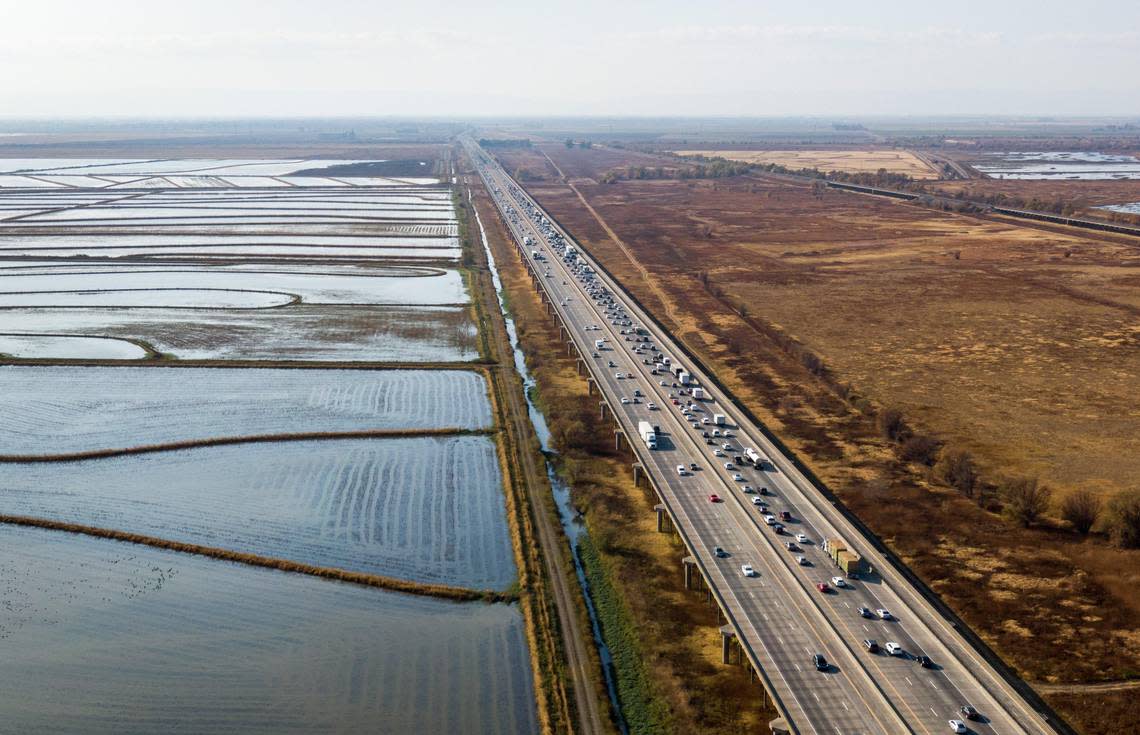As he heads to the Vatican, Gov. Newsom is failing on climate change | Opinion

- Oops!Something went wrong.Please try again later.
Gov. Gavin Newsom is flunking a key climate change test within a stone’s throw of the Capitol. A freeway widening project on parts of Highway 50 and Interstate 80 is moving forward under his leadership that is in blatant defiance of the Sacramento region’s climate change strategy to dramatically move motorists into carpools.
When the governor visits the Vatican later this week to attend an international climate change summit, he has reason to confess a Sacramento sin. Instead of doing the hard work of real leadership, risking the annoyance of some commuters by compelling them to use carpool lanes that produce less emissions, Newsom has instead ducked this issue for months.
Team Newsom is siding with the road builders of the California Department of Transportation and ignoring his own Air Resources Board and their two blistering critiques of the coveted Caltrans project to widen freeway lanes between Sacramento and Davis. The Air Resources Board says this project will worsen the effects of climate change, but Caltrans and Newsom and trying their damndest to ignore them. Oh, and they are also ignoring the six-county Sacramento Area Council of Governments (SACOG), who want more carpool lanes.
Newsom is no Jerry Brown, a governor who was willing to take on CalTrans from his very first term, when necessary. When it comes to road building, Newsom has far more in common with Donald Trump, pretending that unpopular moves to tackle the globe’s biggest challenge aren’t really necessary.
Opinion
There is nothing popular about reversing the effects of climate change. It will demand some big changes in human behavior to reduce the gas emissions that contribute to trapping the sun’s heat and causing drier rainy seasons and temperatures to rise.
This is where Newsom’s approach to climate change falls apart. Newsom, the Democrat leadership in Sacramento and Caltrans simply don’t want to be associated with that is hard to do or unpopular because it requires all of us to change our behavior, use carpool lanes, and drive less.
The carpool lane has been a rare species for years in the Sacramento region. A toll lane has never yet existed. We are used to driving around unimpeded, save for the traffic. . The average Sacramento-area resident, according to SACOG, is in a vehicle for 26 miles every day. That’s a lot of daily driving for every man, woman and child. It’s our contribution to the planet’s climate change problem.
The local mindset associates toll or carpool lanes with the congested Bay Area or the gridlock of Southern California. But Sacramento has grown up, in more ways than one. These high-occupancy freeway lanes must become the norm in the Sacramento region if we are ever to get serious about reducing emissions.
The crucial test case is the region’s very first toll lane project, a $465 million widening. The Yolo Corridor Improvements Project widens stretches of roadway from downtown Sacramento to the Solano County line.
In its recently completed environmental analysis, Caltrans has selected a single express lane for carpools of three occupants or more or solo motorists who would pay a toll. These requirements would only apply for peak commute hours.
While this represents a significant change from Sacramento’s status quo, climate change demands even greater steps to reduce vehicles and emissions on on all the local freeways. Every urban region in California is legally required to submit detailed plans to the Air Board on how to reduce greenhouse gas emissions. SACOG’s plan, submitted to the Air Board in 2020, requires two express lanes on most freeways at rush hour. All that carpooling would reduce the number of vehicles in the express lanes so they can move at top speed. And the two toll lanes would provide tens of millions of dollars of new revenue for transit projects to further reduce emissions.
In December, a Caltrans spokesman said that the department did not study the SACOG plan for two express lanes in its analysis because SACOG did not make the request, This excuse flies in the face of Caltrans guidelines that promote consistency with regional transportation plans.
To understand what happened between SACOG and Caltrans, the Bee Editorial Board filed a Public Records Act request in December to CalTrans for all of its related emails between the two entities. Five months later, Caltrans has failed to produce a single email.
Asked to explain the delay, CalTrans spokesman Dennis Keaton did not respond.
The Newsom administration is no hotbed of transparency. Caltrans’s refusal to provide public records in a timely fashion is sadly typical.
Newsom’s own Air Board has made no progress with Caltrans either. In a scathing letter about CalTrans’ draft environmental report for the Yolo Corridor project, the Air Board blasted the transportation department for underestimating the congestion caused by the project and overestimating the benefits.
For Caltrans, heeding the Air Board’s recommendations would have meant starting from scratch and studying this expansion differently. Caltrans is simply ignoring the state’s top climate change regulator. And Newsom, by his administration’s failure to get its different agencies on the same page, is letting it happen.
The Sacramento region’s first toll lane is on a path to failing the region’s climate change plan. That’s on Newsom. The governor can blame Big Oil all he wants. That we all have to change our ways is an inconvenient truth that Newsom is afraid to address.

